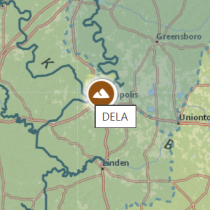Data Notification
Protocol Change for Mosquito Data Products
October 14, 2020
The original mosquito sampling design accommodated two nights of trapping and one day of trapping during each bout (approx. 40 hours of sampling). Due to budget limitations, the sampling design was altered beginning in 2018 to eliminate one night of trapping from each bout resulting in a reduction of the duration of sampling per bout to approximately 24 hours per plot. The change in sampling duration reduced the number of samples generated during a bout; allowing for a reduction in the budget to analyze samples for species composition and pathogen status. All NEON terrestrial sites sample 10 plot locations within the landscape. Before 2018, up to 30 samples could be expected per sampling bout; one sample per mosquito trap during the daytime interval and one sample per mosquito trap during each nighttime interval. After 2018, up to 20 samples can be expected per sampling bout; one sample per mosquito trap during the daytime interval and one sample per mosquito trap during the nighttime interval.
This change from two nights to one night of sampling per bout affects the following data products at all terrestrial sites from collections occurring after 2018-01-01.
- Mosquitoes sampled from CO2 traps (DP1.10043.001)
- Up to 30 field sampling records will be available for affected sites during this time frame. Current sampling regime yields up to 20 field sampling records.
- Mosquito-borne pathogen status (DP1.10041.001)
- The amount of pathogen data produced during this time frame is greater than generated after 2018, because more samples collected from the field were available for pathogen testing.
- Mosquito sequences DNA barcode (DP1.10038.001)
- Impact of this change on data values: Because there were more samples (and thus species) collected from the field during this time frame, a greater diversity of individuals were available for DNA sequencing during this time. This change did not impact the quantity of individuals sent for DNA barcoding.
The reduced quantity of sampling (starting in 2018), is currently being reviewed by the Mosquito Technical Working Group. Pending their evaluation, alternate design options may be implemented to produce data that adequately address the needs of the suite of mosquito data products. Please use the data portal contact form for further inquiries; select DP1.10043.001 in the Data Product dropdown list.
